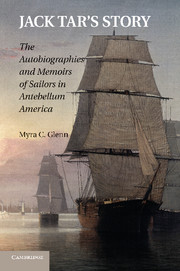Book contents
- Frontmatter
- Contents
- Acknowledgments
- List of Abbreviations
- Introduction: Why Study Antebellum Sailor Narratives
- 1 Stories of Escape, Freedom, and Captivity: Seamen Authors Recall Their Early Years
- 2 Manhood, Nationalism, and Sailor Narratives of British Captivity and the War of 1812
- 3 Exploring the Meaning of Revolution in the Americas: Sailor Narratives of the Haitian and South American Wars of Independence
- 4 Defending One's Rights as a Man and an American Citizen: Sailor Narratives as Exposés of Flogging
- 5 Straddling Conflicting Notions of Masculinity: Sailor Narratives as Stories of Roistering and Religious Conversion
- Afterword
- Appendix
- Index
Introduction: Why Study Antebellum Sailor Narratives
Published online by Cambridge University Press: 05 October 2010
- Frontmatter
- Contents
- Acknowledgments
- List of Abbreviations
- Introduction: Why Study Antebellum Sailor Narratives
- 1 Stories of Escape, Freedom, and Captivity: Seamen Authors Recall Their Early Years
- 2 Manhood, Nationalism, and Sailor Narratives of British Captivity and the War of 1812
- 3 Exploring the Meaning of Revolution in the Americas: Sailor Narratives of the Haitian and South American Wars of Independence
- 4 Defending One's Rights as a Man and an American Citizen: Sailor Narratives as Exposés of Flogging
- 5 Straddling Conflicting Notions of Masculinity: Sailor Narratives as Stories of Roistering and Religious Conversion
- Afterword
- Appendix
- Index
Summary
Horace Lane (1789–1866) was in desperate trouble in the late 1830s. Alcoholism had destroyed both his health and seafaring career. It had also led to his imprisonment in Auburn and Sing Sing Prisons for burglary. By 1839 Lane was an ailing, destitute ex-convict and sailor with little family and no prospects for work. By contrast, Richard Henry Dana Jr. (1815–1882) came from a prominent New England family and had a bright future. A graduate of Harvard College and Law School, Dana began a long, prosperous career as an attorney, writer, and political activist in the early 1840s.
Despite their obvious differences, Dana and Lane shared common experiences. Both men were sailors on the high seas during the first half of the nineteenth century. Each also published an autobiographical narrative recalling their seafaring years. Dana's Two Years Before the Mast (1840) was a bestseller, earning its publisher Harper and Brothers $10,000 in the first two years of publication. By contrast, Lane's autobiography The Wandering Boy failed to attract much attention and had only one printing.
Lane's and Dana's books appeared when the American reading public sought stories about seafaring travels and adventures. Hundreds of short stories, novellas, and novels churned out tales about nefarious pirates, dashing naval officers, and beautiful women on the high seas. James Fenimore Cooper, now best remembered for his Leatherstocking Tales, first became a literary success through such sea novels as The Pilot and Red Rover, published respectively in 1824 and 1827.
- Type
- Chapter
- Information
- Jack Tar's StoryThe Autobiographies and Memoirs of Sailors in Antebellum America, pp. 1 - 23Publisher: Cambridge University PressPrint publication year: 2010

